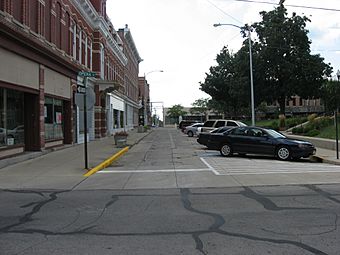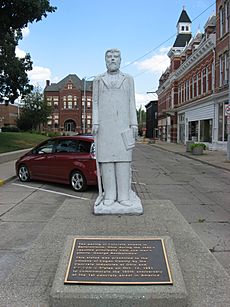Court Avenue facts for kids
Quick facts for kids |
|
|
First Concrete Street In U.S.
|
|

Westward along Court Avenue
|
|
| Location | Bellefontaine, Ohio, United States |
|---|---|
| Area | less than one acre |
| Built | 1893 |
| Architect | George Bartholomew |
| NRHP reference No. | 74001547 |
| Added to NRHP | February 25, 1974 |
Court Avenue is a special street in downtown Bellefontaine, Ohio. It's famous for being the very first street in the United States to be paved with concrete. This happened way back in 1893. You can find it right next to the Logan County Courthouse.
Contents
How It All Started
Before 1893, Court Avenue and other streets in Bellefontaine were just dirt roads. This meant they could get very dusty when dry or super muddy when it rained.
In 1886, a man named George Bartholomew moved to Logan County. He was a pioneer in using concrete. He found that the area had excellent materials for making concrete. By 1891, he had a big idea: why not use concrete to pave streets?
He asked the Bellefontaine city council if he could try paving a small part of Main Street as a test. Some people worried that concrete wouldn't last on a street. But Bartholomew's test patch held up really well!
So, in 1893, the city council agreed to let him pave all the streets around the courthouse, including Court Avenue. George Bartholomew provided the concrete materials. A county engineer named James Wonders led the actual work of laying the concrete.
The council was a bit nervous because no one had ever paved a street with concrete before. They made Bartholomew donate the cement. He also had to pay a $5,000 bond. This was like a promise that the pavement would last for at least five years. Because they were so worried about cold weather, they even covered the concrete with sawdust to protect it!
A Street with a Long History
George Bartholomew paved four streets around the courthouse. But over time, Main, Opera, and Columbus Avenues were repaved with asphalt. This happened in the 1950s because a water pipe broke and damaged them.
This means Court Avenue is the only street left with Bartholomew's original concrete pavement. It has become a very important historical site. Many celebrations have taken place to honor its history.
For its 50th anniversary, a large concrete memorial was placed at the courthouse. On its 70th anniversary, it was rededicated. For its 75th anniversary, a special historical marker was put up.
Bartholomew's concrete was incredibly strong. For its first fifty years, it only cost about $1,400 to maintain! That's not much for such an old street. In the 1960s, it needed some reconstruction.
Because of its importance, Court Avenue was added to the National Register of Historic Places on February 25, 1974. Two years later, in 1976, the American Society of Civil Engineers named it a National Historic Civil Engineering Landmark.
Court Avenue Today
In recent years, people have worked hard to preserve Court Avenue. In 1991, there was a big celebration for its 100th birthday. A monument of George Bartholomew was placed at one end of the street. This monument also helped close the street to cars, turning it into a pedestrian mall.
However, not many people used the street as a pedestrian area, except for skateboarders. It also made downtown traffic a bit tricky. So, after a few years, the street was reopened to cars.
The monument to George Bartholomew is still there. It was moved to make sure only the eastbound lane of the street is usable by cars. Today, groups like the Logan County Historical Society want to see the street become car-free again. But many local businesses and residents prefer it to stay open for traffic.
How the Concrete Was Made
The original pavement of Court Avenue was made in two layers, similar to how sidewalks are built. George Bartholomew's special cement was made from clay and limestone.
The concrete also included small stones and sand, called aggregate. The top layer used smaller aggregate (no larger than ½ inch), and the bottom layer used slightly larger aggregate (no larger than 1½ inches). The concrete was mixed by hand!
This concrete was very strong, able to withstand about 34.5 megapascals of pressure, which is over 5,000 psi. The total cost to pave the street was about $9,000, not including the bond Bartholomew paid.
It's interesting to know that the parts of the street that have been repaired over the years haven't lasted as well. The original sections of Bartholomew's concrete are still the strongest and have held up the best!




